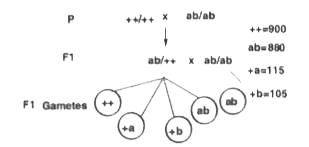In a cross between individuals homozygous for (a, b) and wild type (++). In this cross 700 out of 1000 individuals were of parental type. Then the distance between a and b is :-
70 map unit
35 map unit
30 map unit
15 map unit
The correct Answer is:C
To solve the problem, we need to determine the genetic distance between two genes (a and b) based on the number of recombinant progeny produced in a cross between homozygous individuals for these genes and wild-type individuals. Here’s a step-by-step breakdown of the solution:
Step 1: Understand the Cross
- We have two parents: one homozygous for alleles (a, b) and the other homozygous for wild-type alleles (+, +).
- The parental types are (a, b) and (+, +).
Step 2: Identify the Progeny Types
- In this cross, we are told that out of 1000 progeny, 700 are of parental type.
- This means that the remaining progeny are recombinant types.
Step 3: Calculate the Number of Recombinant Progeny
- Total progeny = 1000
- Parental type progeny = 700
- Therefore, the number of recombinant progeny = Total progeny - Parental type progeny = 1000 - 700 = 300.
Step 4: Use the Formula for Genetic Distance
- The formula to calculate the distance between two genes (in map units) is:
Distance (in map units)=(Number of recombinant progenyTotal progeny)×100
Step 5: Substitute the Values into the Formula
- Number of recombinant progeny = 300
- Total progeny = 1000
Substituting these values into the formula gives:
Distance=(3001000)×100=30 map units
Final Answer
- The distance between genes a and b is 30 map units.
---
- We have two parents: one homozygous for alleles (a, b) and the other homozygous for wild-type alleles (+, +).
- The parental types are (a, b) and (+, +).
- In this cross, we are told that out of 1000 progeny, 700 are of parental type.
- This means that the remaining progeny are recombinant types.
- Total progeny = 1000
- Parental type progeny = 700
- Therefore, the number of recombinant progeny = Total progeny - Parental type progeny = 1000 - 700 = 300.
- The formula to calculate the distance between two genes (in map units) is:
Distance (in map units)=(Number of recombinant progenyTotal progeny)×100
- Number of recombinant progeny = 300
- Total progeny = 1000
- The distance between genes a and b is 30 map units.
Topper's Solved these Questions
- GENETICS & MOLECULAR BASIS OF INHERITANCE AND MUTATIONBOOK - ALLENCHAPTER - GENETICS & MOLECULAR BASIS OF INHERITANCE AND MUTATIONEXERCISE - EXERCISE-II (PREVIOUS YEAR QUESTIONS
104 Videos
- GENETICS & MOLECULAR BASIS OF INHERITANCE AND MUTATIONBOOK - ALLENCHAPTER - GENETICS & MOLECULAR BASIS OF INHERITANCE AND MUTATIONEXERCISE - EXERCISE-III (ANALYTICAL QUESTIONS
85 Videos
- GENETICS & MOLECULAR BASIS OF INHERITANCE AND MUTATIONBOOK - ALLENCHAPTER - GENETICS & MOLECULAR BASIS OF INHERITANCE AND MUTATIONEXERCISE - DEGINNERS BOX-8
5 Videos
- GENETICS BOOK - ALLENCHAPTER - GENETICS EXERCISE - Question
58 Videos
- GENETICS (PRINCIPLES OF INHERITANCE AND VARIATION) (MOLECULAR BASIS OF INHERITANCE)BOOK - ALLENCHAPTER - GENETICS (PRINCIPLES OF INHERITANCE AND VARIATION) (MOLECULAR BASIS OF INHERITANCE)EXERCISE - Question
53 Videos
Similar Questions
In a cross between genotype AB and ++,650 out of 1000 individuals were of parental type The distance between A and B
View SolutionBy the cross of F1 linked dihybrid plant with a plant of genotype aabb, we get the 1300 plants out of 2000 of parental type. The distance between A and B gene is :-
View Solution
Knowledge Check
Result of a cross between a normal homozygous female and a haemophiliac male would be
Anormal males and normal femalesBhaemophilic males and normal femalesCnormal males and carrier femalesDhaemophilic males and carrier females
A cross between two heterozygous individuals will yield homozygous individuals
View SolutionA cross between F1 hybrid and its homozygous recessive parent is called
View SolutionA cross between F1 hybrid and its homozygous recessive parent is called
View SolutionA cross between hybrid and either of any parent is called
View SolutionA cross used to ascertian whether an individual is dominant homozygous or heterozygous is termed :
View SolutionIf a cross between two individuals produces offsprings with 50% dominant character (A) and 50% recessive character (a) the genotype of parents are:
View SolutionIndividuals homozygous for ab genes were crossed with wild type (++). The F1 hybrid thus produced was test crossed. It produces progeny in following proportion.

Now, calculate the distance between a and b genes.
View Solution
